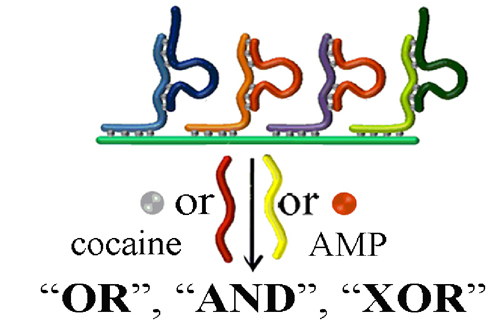Logic Gates and Antisense DNA Devices Operating on a Translator Nucleic Acid Scaffold B. Shlyahovsky, Y. Li, O. Lioubashevski, J. Elbaz and I. Willner ACS Nano. 3, 1831-1843 (2009).  A series of logic gates, "AND", "OR", and "XOR", are designed using a DNA scaffold that includes four "footholds" on which the logic operations are activated.? Two of the footholds represent input-recognition strands, and these are blocked by complementary nucleic acids, whereas the other two footholds are blocked by nucleic acids that include the horseradish peroxidase (HRP)-mimicking DNAzyme sequence. The logic gates are activated by either nucleic acid inputs that hybridize to the respective ?footholds?, or by low-molecular-weight inputs (adenosine monophosphate or cocaine) that yield the respective aptamer-substrate complexes. This results in the respective translocation of the blocking nucleic acids to the footholds carrying the HRP-mimicking DNAzyme sequence, and the concomitant release of the respective DNAzyme. The released product-strands then self-assemble into the hemin/G-quadruplex-HRP-mimicking DNAzyme that biocatalyzes the formation of a colored product and provides an output signal for the different logic gates. The principle of the logic operation is, then, implemented as a possible paradigm for future nano-medicine.? The nucleic acid inputs that bind to the blocked footholds result in the translocation of the blocking nucleic acids to the respective footholds carrying the anti-thrombin aptamer. The released aptamer inhibits, then, the hydrolytic activity of thrombin. The system demonstrates the regulation of a biocatalytic reaction by a translator system activated on a DNA scaffold. ? 
|


